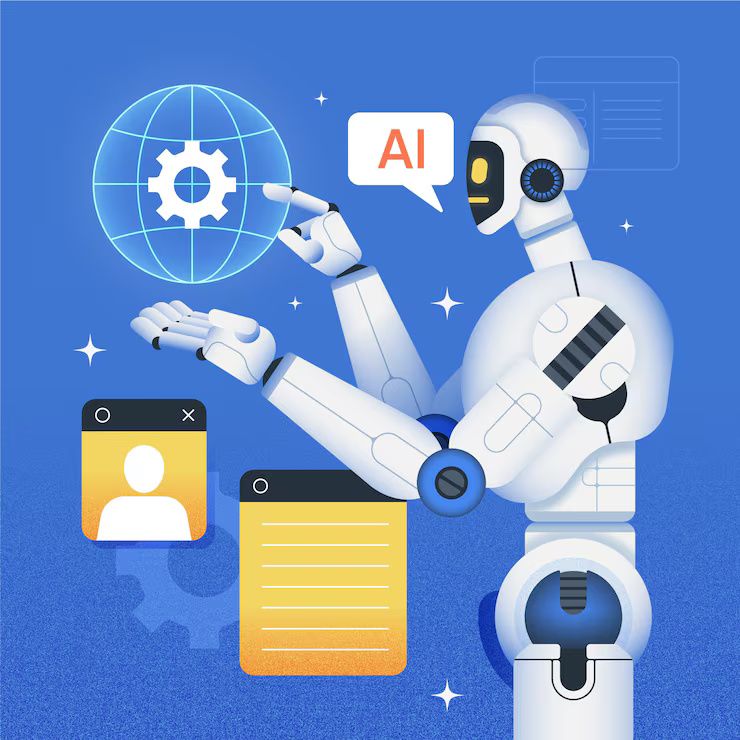Artificial intelligence (AI) refers to computer systems capable of performing tasks that usually require human intelligence, such as problem-solving, learning, and decision-making. In education, AI is being integrated into teaching, learning, and administrative processes. Its adoption is driven by the growing need to personalize learning, enhance efficiency, and improve accessibility for students worldwide
AI systems can analyze large datasets to provide insights about student performance, recommend learning resources, automate administrative tasks, and even create adaptive learning pathways for individual students. By leveraging AI, educators can focus more on teaching and mentorship while leaving repetitive or data-heavy tasks to technology.

Why AI in Education Matters
The integration of AI in education is important for several reasons:
-
Personalized Learning: AI tools can tailor lesson plans to match a student’s pace and learning style, ensuring better understanding and retention.
-
Accessibility and Inclusion: AI-powered tools can support students with disabilities through speech recognition, text-to-speech, and language translation.
-
Efficiency for Educators: Grading, attendance tracking, and content delivery can be automated, reducing workload for teachers.
-
Data-Driven Insights: AI can monitor student engagement, identify learning gaps, and provide actionable insights for educators and administrators.
-
Global Reach: AI-powered online platforms make quality education accessible to students in remote areas.
AI affects students, teachers, administrators, and policymakers, offering solutions to problems such as inconsistent instruction quality, limited resources, and the challenge of addressing diverse learning needs.
Recent Trends in AI for Education
Over the past year, several trends have shaped the use of AI in education:
-
Adaptive Learning Platforms: Platforms like Century Tech and Squirrel AI in 2024 have enhanced their AI engines to provide real-time feedback and adjust learning paths based on student performance.
-
AI Tutors and Chatbots: AI tutors such as Carnegie Learning’s MATHia have improved interactive support for subjects like mathematics and science. Chatbots now provide 24/7 assistance for student queries.
-
Assessment and Grading: AI-assisted grading tools have become more accurate, particularly for subjective assignments such as essays, saving educators hours of manual work.
-
AI in Higher Education Admissions: Universities in 2024 increasingly use AI to screen applications, detect plagiarism, and predict student success rates based on past academic performance.
-
Language Learning AI: AI-driven language platforms now offer adaptive exercises, pronunciation correction, and personalized learning paths in multiple languages.
These innovations demonstrate AI’s expanding role in education, making learning more interactive, customized, and efficient.
Laws, Policies, and Regulations
The use of AI in education is influenced by legal and policy frameworks that focus on privacy, equity, and safety:
-
Data Privacy: Regulations such as the Family Educational Rights and Privacy Act (FERPA) in the United States and similar laws in other countries govern how student data can be collected, stored, and used. AI tools must comply with these requirements.
-
Digital Equity Policies: Governments are increasingly funding AI initiatives to ensure all students, including those in underserved areas, can access advanced learning technologies.
-
Ethical Guidelines for AI: Policies are emerging to prevent bias in AI algorithms, ensure transparency, and maintain accountability in automated decision-making in educational institutions.
-
AI Research Funding: Many countries provide grants and programs to support research into AI applications for education, promoting innovation while ensuring compliance with legal and ethical standards.
Compliance with these laws and policies ensures that AI in education is safe, inclusive, and effective.
Tools and Resources for AI in Education
Several tools, apps, and platforms demonstrate the practical applications of AI in learning:
| Tool/Platform | Function | Benefit |
|---|---|---|
| Century Tech | Adaptive learning engine | Personalizes lesson plans and tracks student progress |
| Squirrel AI | AI tutoring system | Offers targeted learning for subjects and skills |
| MATHia | AI-driven math tutor | Provides real-time feedback and personalized practice |
| Grammarly | AI writing assistant | Improves grammar and clarity in student writing |
| Duolingo | AI language learning | Adjusts difficulty and recommends exercises |
| Turnitin | AI plagiarism detection | Ensures academic integrity in assignments |
| Coursera AI Modules | AI-powered course recommendations | Suggests courses based on student progress and interests |
| IBM Watson Education | AI insights for educators | Analyzes learning patterns and predicts outcomes |
| Khan Academy AI | Adaptive exercises | Customizes exercises to student level |
| Microsoft Education AI | Virtual classrooms and support | Enhances collaboration and accessibility |
These resources empower educators and learners to leverage AI effectively while maintaining focus on educational outcomes.
Frequently Asked Questions
Q1: Can AI replace teachers?
A: No. AI is a tool to assist educators. Human guidance, mentorship, and emotional support are still crucial. AI complements teaching rather than replacing it.
Q2: Is AI in education safe for student privacy?
A: When platforms comply with data privacy regulations and ethical guidelines, student information is protected. Schools must ensure proper consent and secure data handling.
Q3: How can AI help students with disabilities?
A: AI tools provide text-to-speech, speech recognition, and adaptive learning features, supporting students with visual, auditory, or learning impairments.
Q4: Are AI learning platforms expensive?
A: Costs vary. Many platforms offer free versions or tiered pricing. Investment in AI is often offset by improved learning outcomes and efficiency for teachers.
Q5: Will AI improve education for all countries?
A: AI has potential to reduce educational inequities, but infrastructure, access, and policy support are crucial. Countries must invest in digital infrastructure and training to maximize benefits.
Summary
Artificial intelligence is transforming education by making learning more personalized, accessible, and efficient. It empowers students, supports teachers, and provides data-driven insights for administrators. By integrating AI responsibly, complying with privacy laws, and leveraging effective tools, educational institutions can enhance outcomes, reduce disparities, and prepare learners for a rapidly changing world.

